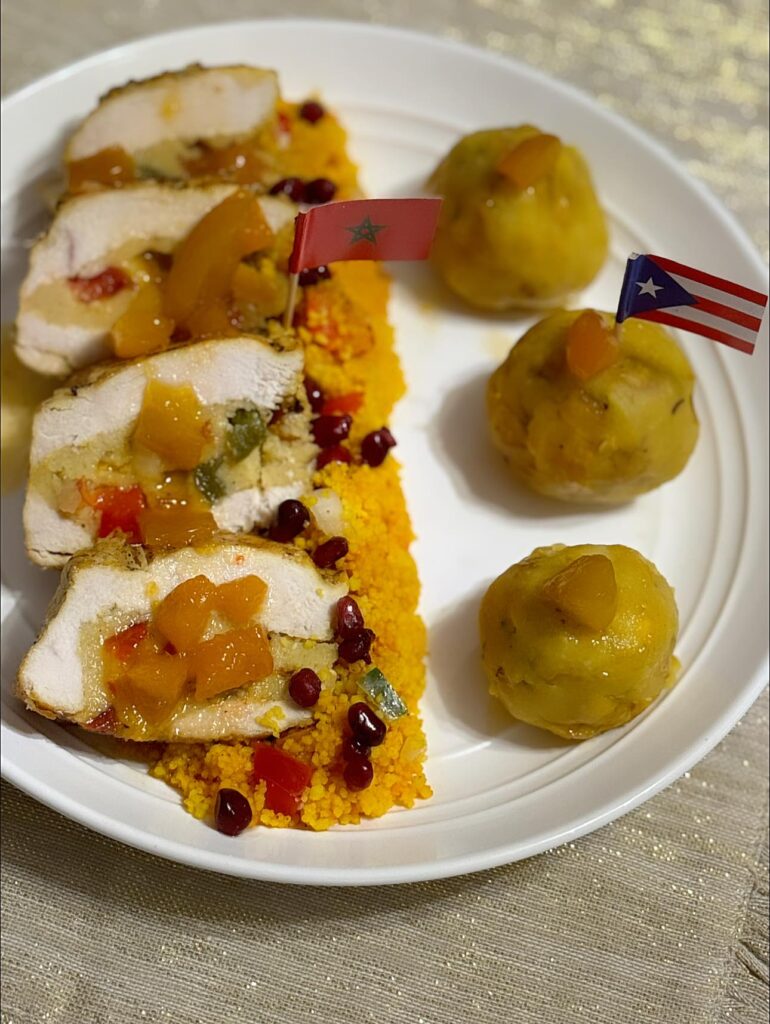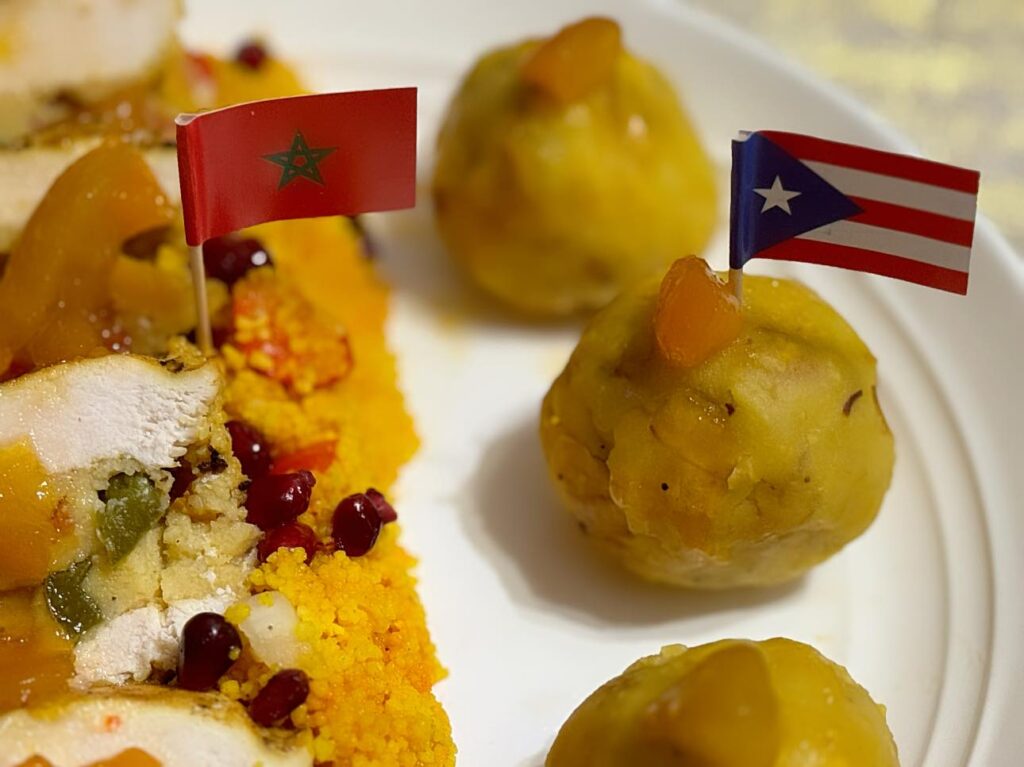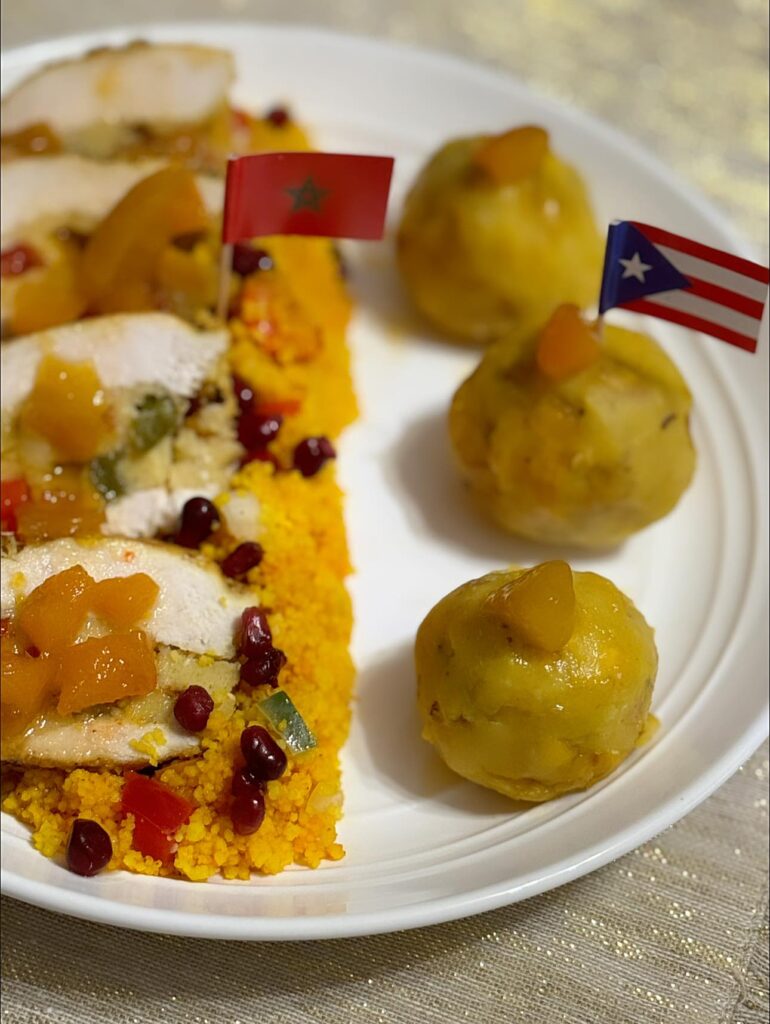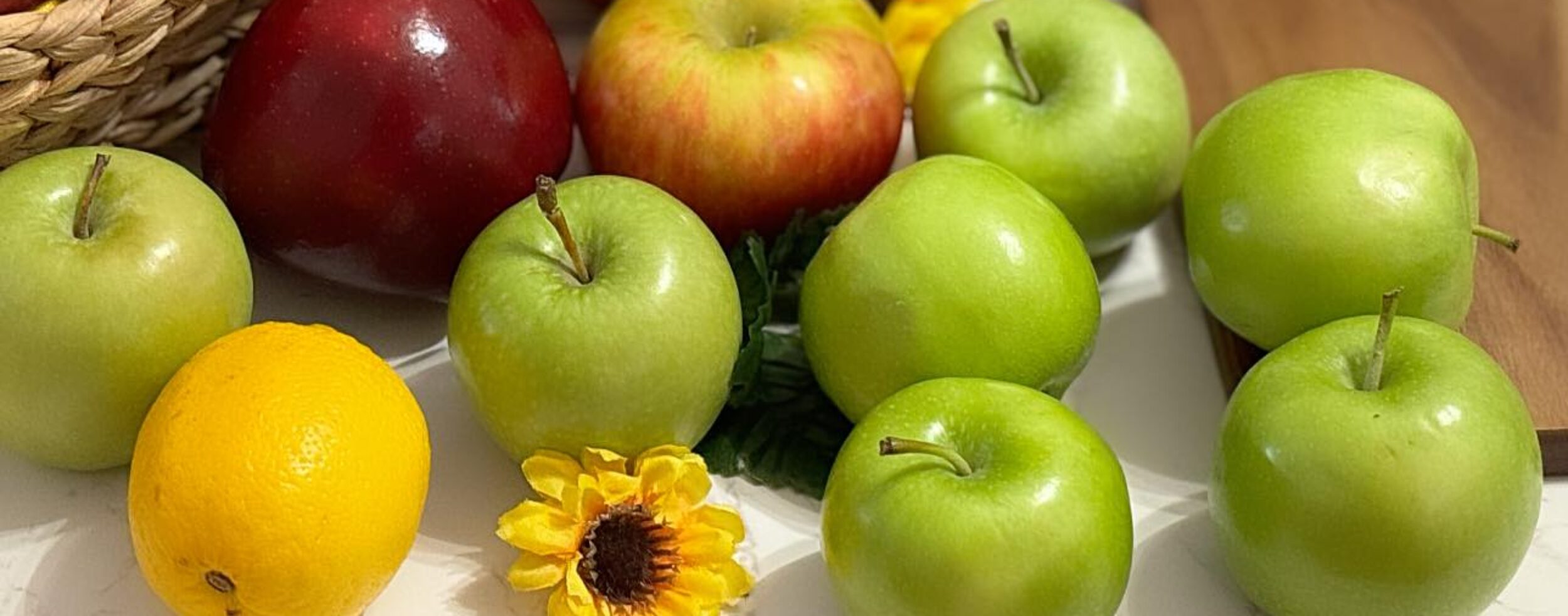Introducing World Culinary Fusions Edition
Enter the “World Culinary Fusions Edition” – a recipe collection that transcends geographical boundaries and invites you to savor global flavors in a single, flavorful plate. While my roots are firmly planted in the Caribbean, the world is a vast tapestry of tastes waiting to be explored. The World Culinary Fusions Edition is a celebration of this diversity, a journey beyond the tropics into a global culinary adventure. Drawing inspiration from different corners of the world, this collection showcases my commitment to bringing you a culinary experience that goes beyond borders. It’s a nod to the incredible variety that makes our world a gastronomic marvel.
Why Morocco & Puerto Rico?
This culinary journey fuses the vibrant flavors of Morocco and the rich traditions of Puerto Rico is a celebration of diverse tastes and cultural influences. In this unique recipe, we marry the aromatic essence of Moroccan couscous-stuffed chicken breast with the soulful comfort of Puerto Rican Mofongo balls, creating a symphony of flavors that dance on the palate.
Located in North Africa, Morocco is known for its rich history, vibrant markets, and a diverse culinary palette influenced by Berber, Arab, and Mediterranean cultures. Nestled in the Caribbean, Puerto Rico boasts a tropical climate and a fusion of Taino, Spanish, African, and American influences in its cuisine. The fusion of Moroccan and Puerto Rican cuisines brings together contrasting yet complementary elements, offering a culinary journey that reflects my passion for exploring global flavors. It adds a unique touch to your World Fusions Edition, showcasing the beauty of diverse culinary traditions converging on a single plate.

Bringing Couscous & Mofongo Together in One Dish:
Morocco and Puerto Rico may be separated by vast oceans, but in the realm of culinary exploration, they come together harmoniously. The geographical and cultural diversity of these regions finds expression in their distinct yet complementary ingredients, cooking techniques, and flavor profiles.
Couscous, the jewel of Moroccan cuisine, holds a special place in the hearts and homes of Moroccans. An integral part of their culinary tradition, couscous is lovingly prepared and savored every Friday, a practice that brings families and communities together.
Mofongo is a traditional Puerto Rican dish that holds a special place in the heart of the island’s culinary heritage. This iconic dish consists of mashed green plantains, often combined with other ingredients like garlic, olive oil, and sometimes pork cracklings (chicharrones). The green plantains are peeled, fried until golden and crispy, and then mashed using a wooden mortar and pestle called a pilón.
The marriage of Moroccan spices with the heartiness of Puerto Rican staples results in a taste profile that is nothing short of enchanting. The couscous brings a fragrant, nutty undertone, while the Mofongo balls contribute a delightful savory note. The apricot glaze ties the elements together with a burst of sweetness and tartness, creating a culinary experience that transcends borders.
This culinary fusion of Moroccan couscous-stuffed chicken breast and Puerto Rican Mofongo balls is a celebration of diversity, reflecting the beauty that arises when culinary traditions collide. Each bite tells a story of two distant lands, united on a plate, inviting you to savor the richness of global flavors in the comfort of your own home.

Moroccan Couscous-Stuffed Chicken Breast:
- Ingredients:
- 1 cup couscous
- 1 1/2 cups chicken or vegetable broth
- 1/2 cup diced bell peppers (assorted colors for visual appeal)
- 1/2 teaspoon ras el hanout (Moroccan spice blend) see note below for substitution.
- 1 tablespoon orange blossom water
- 1/4 cup almonds, chopped for a crunch
- 1/2 teaspoon turmeric
- 1 teaspoon of lemon juice
- 1 small onion, finely chopped
- Salt to taste
- 1/2 cup diced tomatoes
*Note: If you don’t have Ras el Hanout available to you, you can also make a blend of ginger, cinnamon, cardamom, ground cloves and other warming aromatics.
Instructions:
- In a pot, bring the broth to a boil.
- In a separate bowl, combine couscous, diced bell peppers, ras el hanout, orange blossom water, almonds, turmeric, cinnamon, coriander, lemon juice, and zest.
- Pour the boiling broth over the couscous mixture, cover, and let it sit for about 10 minutes or until the liquid is absorbed.
- Fluff the couscous with a fork to separate the grains.
- Sauté chopped onion until translucent and add it to the couscous.
- Gently fold in diced tomatoes.
- Adjust salt to taste.
Preparing & Stuffing the Chicken:
- Begin with boneless, skinless chicken breasts.
- Sprinkle and rub your favorite all-purpose seasoning generously on both sides of the chicken breasts. Ensure that each breast is well-coated. You can also just use salt and pepper is you wish.
- Using a sharp knife, make a horizontal cut along the longer side of the chicken breast, parallel to the cutting board.
- Ensure not to cut all the way through; the goal is to create a pocket within the thicker side.
- Spoon the prepared couscous mixture into the pocket of each chicken breast.
- Seal the chicken breasts using toothpicks if you wish.
- In a hot skillet, sear the stuffed chicken breasts on both sides until they achieve a beautiful golden brown color. This initial searing locks in the juices and adds a delightful crust to the exterior.
- Reduce the heat to medium-low and continue cooking the stuffed chicken breasts until they reach a safe internal temperature and the couscous filling is fully cooked. This ensures a harmonious blend of textures and flavors.
Preparing the Mofongo Balls:

- Peel and cut three to four large plantains into about 1 and a half thick inch pieces, and deep fry until golden brown.
- Mash the fried plantains in a pilon (wooden mortar and pestle) with olive oil, butter, broth, salt, pepper, and garlic paste until you achieve a smooth consistency. You can start with four tablespoons of butter, 1 tablespoon of garlic paste, and the olive oil and broth are really up to individual preference. For instance, you can add a drizzle of olive oil at a time, and you can use 1/4 cup of chicken broth at a time. These provide additional moisture to the mofongo dough. Add salt and pepper to taste and you should have beautifully soft mofongo that is savory and moist. Your mofongo dough should be soft but firm enough to shape.
- Form the mashed plantains into balls. Set aside.
Prepare the Apricot Glaze:

- In a saucepan, combine approximately 1/4 cup of apricot jam, 3-4 diced canned apricots, and a bit of syrup from the canned apricots. I would say about 1/3 cup of syrup.
- Cook the mixture on the stove until it forms a glaze.
Bringing Everything Together:
Now it’s time to assemble your plate with your wonderful creations.
- Place the stuffed and cooked chicken breast on a cutting board.
- Use a sharp knife to cut the stuffed chicken breast into neat, diagonal slices. This cutting style not only enhances the presentation but also reveals the couscous stuffing.
- Prepare a bed of additional couscous on each serving plate. This couscous will complement the stuffed chicken and absorb the delicious flavors from the dish.
- Artfully arrange the sliced chicken on top of the bed of couscous. Overlapping the slices creates a dynamic and appealing display.
- Sprinkle fresh pomegranate arils and toasted almonds over the chicken and couscous. This not only adds vibrant colors but also introduces additional textures and flavors.
- Place the Mofongo balls gracefully on the side of the plate, forming a balanced composition. Ensure they are visible and easily accessible for a diverse dining experience.
- Use a spoon to drizzle the apricot glaze over the sliced chicken and Mofongo balls. The glaze adds a glossy finish and imparts a sweet and tangy flavor to the dish.
- Consider garnishing the plate with a few extra pomegranate arils and chopped almonds for a finishing touch.
This visually appealing and thoughtfully assembled plate showcases the fusion of Moroccan and Puerto Rican flavors. It not only delights the taste buds but also provides a feast for the eyes. Enjoy your culinary creation!



